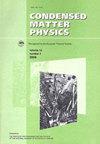Quantum fluctuations approach to the nonequilibrium GW approximation
IF 1
4区 物理与天体物理
Q4 PHYSICS, CONDENSED MATTER
引用次数: 4
Abstract
The quantum dynamics of fermionic or bosonic many-body systems following external excitation can be successfully studied using two-time nonequilibrium Green's functions (NEGF) or single-time reduced density matrix methods. Approximations are introduced via a proper choice of the many-particle self-energy or decoupling of the BBGKY hierarchy. These approximations are based on Feynman's diagram approaches or on cluster expansions into single-particle and correlation operators. Here, we develop a different approach where, instead of equations of motion for the many-particle NEGF (or density operators), single-time equations for the correlation functions of fluctuations are analyzed. We present a derivation of the first two equations of the alternative hierarchy of fluctuations and discuss possible decoupling approximations. In particular, we derive the polarization approximation (PA) which is shown to be equivalent to the single-time version [following by applying the generalized Kadanoff-Baym ansatz (GKBA)] of the nonequilibrium GW approximation with exchange effects of NEGF theory, for weak coupling. The main advantage of the quantum fluctuations approach is that the standard ensemble average can be replaced by a semiclassical average over different initial realizations, as was demonstrated before by Lacroix and co-workers [see e.g. D. Lacroix et al., Phys. Rev. B, 2014, 90, 125112]. Here, we introduce the stochastic GW (SGW) approximation and the stochastic polarization approximation (SPA) which are demonstrated to be equivalent to the single-time GW approximation without and with exchange, respectively, in the weak coupling limit. In addition to the standard stochastic approach to sample initial configurations, we also present a deterministic approach. Our numerical tests confirm that our approach has the same favorable linear scaling with the computation time as the recently developed G1-G2 scheme [Schluenzen et al., Phys. Rev. Lett., 2020, 124, 076601]. At the same time, the SPA and SGW approaches scale more favorably with the system size than the G1-G2 scheme, allowing to extend nonequilibrium GW calculations to bigger systems.非平衡GW近似的量子涨落方法
利用二次非平衡格林函数(NEGF)或单次约化密度矩阵方法,可以成功地研究外部激励下费米子或玻色子多体系统的量子动力学。通过适当选择多粒子自能或BBGKY层次的解耦来引入近似。这些近似是基于费曼图方法或基于簇展开成单粒子和相关算子。在这里,我们开发了一种不同的方法,在这种方法中,我们分析了波动相关函数的单时间方程,而不是多粒子NEGF(或密度算子)的运动方程。我们给出了可选波动层次的前两个方程的推导,并讨论了可能的解耦近似。特别是,对于弱耦合,我们推导出极化近似(PA),它被证明与具有NEGF理论交换效应的非平衡GW近似的单时间版本等效[随后应用广义Kadanoff-Baym ansatz (GKBA)]。量子涨落方法的主要优点是,标准系综平均可以被不同初始实现的半经典平均所取代,正如拉克鲁瓦及其同事之前所证明的那样(参见D. Lacroix et al., Phys.)。[j].生物工程学报,2014,29(1):1212 - 1212。本文介绍了在弱耦合极限下,随机GW近似(SGW)和随机极化近似(SPA)分别等价于无交换和有交换的单次GW近似。除了样本初始配置的标准随机方法外,我们还提出了一种确定性方法。我们的数值测试证实,我们的方法与最近开发的G1-G2方案在计算时间上具有同样有利的线性缩放[Schluenzen et al., Phys]。启。[j].农业工程学报,2020,24,076601。与此同时,SPA和SGW方法比G1-G2方案更适合系统规模,允许将非平衡GW计算扩展到更大的系统。
本文章由计算机程序翻译,如有差异,请以英文原文为准。
求助全文
约1分钟内获得全文
求助全文
来源期刊

Condensed Matter Physics
物理-物理:凝聚态物理
CiteScore
1.10
自引率
16.70%
发文量
17
审稿时长
1 months
期刊介绍:
Condensed Matter Physics contains original and review articles in the field of statistical mechanics and thermodynamics of equilibrium and nonequilibrium processes, relativistic mechanics of interacting particle systems.The main attention is paid to physics of solid, liquid and amorphous systems, phase equilibria and phase transitions, thermal, structural, electric, magnetic and optical properties of condensed matter. Condensed Matter Physics is published quarterly.
 求助内容:
求助内容: 应助结果提醒方式:
应助结果提醒方式:


